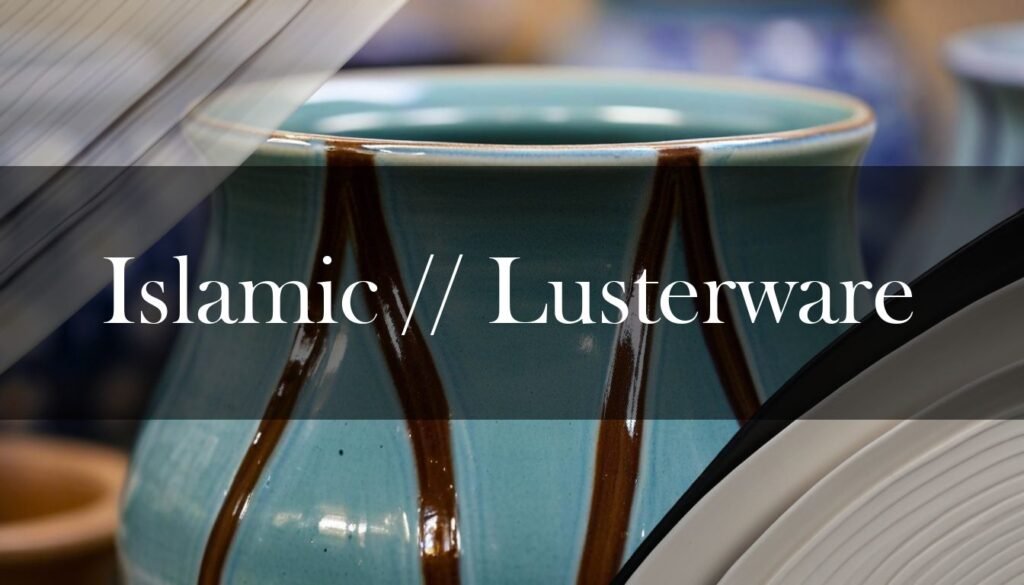Islamic lusterware, with its mesmerizing, iridescent sheen, represents one of the most fascinating achievements in ceramic history. This unique pottery, adorned with metallic glazes, evolved through several key periods, each leaving its distinctive mark on the craft. From its humble beginnings in Mesopotamia to its revival in Safavid Persia, lusterware stands as a testament to the innovation, artistry, and cultural exchange that characterized the Islamic world.
The story of lusterware begins in the 9th century, during the Abbasid Caliphate in modern-day Iraq. Cities like Baghdad and Basra became the cradle of this new art form, producing mainly small bowls decorated with multiple luster colors derived from silver and copper compounds. These early pieces, fragments of which have been found across vast distances, showcase the nascent stages of a technique that would soon spread far and wide. Following the Fatimid conquest of Egypt in 969, Cairo (then Fustat) emerged as another significant center. Here, lusterware production flourished, with artisans creating intricate designs on tiles and vessels that were *highly sought after*. The decline of the Fatimid Caliphate, however, led to the dispersal of these artisans, carrying their knowledge and skills to other regions, including Syria and Persia. The Seljuk period saw Kashan, in central Iran, rise to prominence. This era marked advancements in ceramic technology, with the development of stonepaste (fritware) that mimicked the appearance of Chinese porcelain. Kashan’s luster-painted ceramics, known for their intricate designs and inscriptions, are among the most exquisite examples of Persian pottery. Later, during the Safavid period in the 17th and 18th centuries, lusterware experienced a revival. This time, the style shifted towards smaller pieces with dark copper designs over a dark blue background, a departure from the earlier Chinese-inspired motifs. Throughout these periods, lusterware adapted and evolved, reflecting the unique artistic sensibilities of each region and era.
The magic of Islamic lusterware lies in its distinctive metallic sheen, achieved through a complex process involving specific materials and firing conditions. The primary colors used in lusterware include white, derived from tin-opacified glazes, blue from cobalt oxide, green from copper oxide, and yellow and amber from silver-based pigments. These colors were applied to a previously glazed ceramic piece, which was then fired again in a reducing atmosphere. This crucial step caused the metal ions to migrate to the surface, forming a thin, reflective layer of metal nanoparticles that give lusterware its characteristic iridescence. Silver oxide was used to create golden and yellow effects, while copper oxide produced red and ruby hues. The process demanded precise control and a deep understanding of chemistry, turning simple materials into objects of stunning beauty. Learn more about glaze chemistry with this guide to unlocking glaze chemistry.
Abu’l-Qasim’s treatise (1301) mentions the use in the Kashan pottery industry of verdigris [= green copper oxide] and lead oxide [= red lead or ‘litharge’], as well as silver, iron sulphate, red and yellow arsenic, gold and silver.
The motifs and designs found on Islamic lusterware are as diverse as the cultures that produced them. Geometric patterns, a hallmark of Islamic art, are frequently seen in lusterware, featuring interlacing polygons, stars, and tessellations that symbolize unity and infinity. Arabesque and floral motifs, with their stylized, flowing foliage, represent the transcendent nature of life and the universe. *Calligraphic inscriptions*, often verses from the Quran or poetry, add another layer of meaning to these ceramic pieces, serving both decorative and communicative purposes. While traditional Islamic art generally avoids figural representations, some lusterware, particularly from Persia, includes human and animal figures, integrated into the overall design. One notable example is the “rock and wave” design, borrowed from Chinese porcelain, which depicts turbulent waves crashing onto rocks. These artistic elements, combined with regional variations and symbolic motifs believed to offer protection, make Islamic lusterware a rich tapestry of cultural and artistic expression. For more on the influence of Chinese porcelain, check out this article.
These motifs are characterized by rhythmic linear patterns of scrolling and interlacing foliage, tendrils which are often combined with other elements.
Today, numerous museums around the world house exquisite examples of Islamic lusterware, allowing us to appreciate the beauty and historical significance of this art form. The Stockholm Alhambra Vase, a late 14th-century vessel from Granada, Spain, stands as a testament to the craftsmanship of Nasrid artisans. The Cleveland Museum of Art boasts an 11th-century Fatimid lusterware bowl from Egypt, showcasing the mastery of luster-painting during that period. The British Museum holds several Kashan lustre tiles, adorned with animal motifs and Quranic verses, reflecting the funerary significance of these tiles in 13th-century Persia. Other notable collections can be found in the Tareq Rajab Museum in Kuwait and the Khalili Collection of Islamic Art, both of which offer a comprehensive view of Islamic art. These surviving examples of Islamic lusterware, housed in various museums worldwide, illustrate the technique’s beauty and historical significance.





